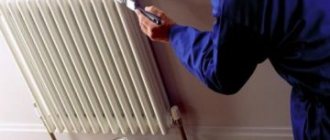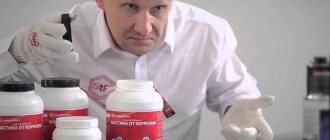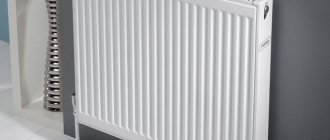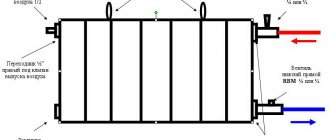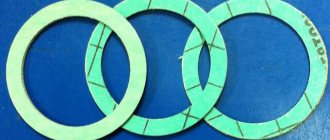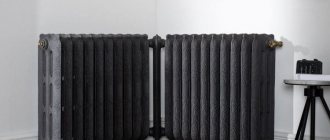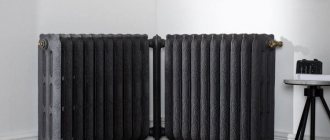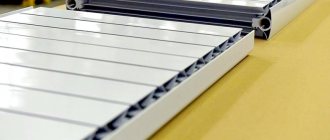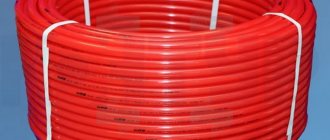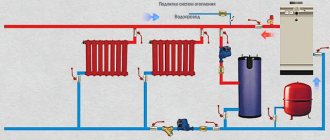Heating radiators in the house require mandatory painting. The best paint for radiators will protect surfaces from adverse external influences and give the room a presentable appearance. From the variety of coating options for pipes and heating radiators, it is better to choose paints and varnishes in accordance with the type of room, operating features, and surrounding design. Basic requirements for paint and varnish materials: durability, reliability of the coating without compromising the integrity of the outer layer during the stated period, resistance to sudden temperature changes, aesthetics, environmental safety without the release of unpleasant odors.
How to paint radiators
The main criterion that is taken into account when choosing a composition for painting heating radiators is the heat resistance of the paint.
Information about technical characteristics is indicated on the packaging. If it is written that the recommended temperature of use is less than +80 degrees, then this composition is not suitable for coloring batteries. When painting with such paint, when it is heated, yellowing and peeling of the coating will occur. This happens due to the polymer components or chalk included in ordinary interior paint, which are not designed for strong heat. In the “right” paint, the binder and pigments are heat resistant. Main characteristics of battery paint:
- heat resistance;
- abrasion resistance;
- moisture resistance;
- no odor when heated;
- high thermal conductivity;
- quick drying.
Battery painting is done in two times. Therefore, it is important that the paint dries quickly. However, you should be prepared for the fact that the faster the composition dries, the more noticeable and pungent its smell.
You should pay attention to the texture that the surface acquires after painting. It comes in matte and glossy. You need to understand that gloss well highlights all the defects of the surface being painted. If a cast iron battery has a rough, bumpy surface, then it is better to choose a dull matte paint for it. Radiator cast iron often has defects, which a glossy coating will only highlight.
In order not to make a mistake with your choice, it is better to purchase paint that has a mark stating that it is intended for painting heating radiators. Such compositions are also marked that they dry quickly after application.
Features of the painting process
Manufacturers of heating devices consider painting them as a violation of the conditions for maintaining the warranty. Therefore, the presence of damage or peeling of factory paint during the warranty period is a manufacturing defect. In this case, instead of repairing it yourself, it is better to contact the seller to replace the defective batteries.
If the warranty period has already expired, and the surface of the radiators requires updating or restoration, then you should take into account the type of metal from which the devices are made. The fact is that aluminum, steel and bimetallic sectional batteries are painted at the factory with polymer paints, followed by heat treatment.
This coating is highly durable, but has very weak surface adhesion. It is almost impossible to paint such products at home without removing the factory paint, and cleaning the metal surface will require considerable effort.
The recommended option for restoring high-quality coatings on aluminum or bimetallic products is the use of epoxy primer and expensive enamels. However, this processing method requires significant financial costs and certain painting skills.
The easiest painting is for cast iron radiators like M-140 and steel convectors. In most cases, this equipment is only primed at the manufacturer and specially prepared for subsequent painting treatment. It is recommended to apply the paint 2 times to ensure a continuous coating to protect the device from corrosion.
The best paints for heating radiators
| Photo | Name | Rating | Price | |||
| The best alkyd paints for heating radiators | ||||||
| #1 | Enamel "Olecolor" | ⭐ 4.95 / 5 4 - votes | Find out the price | |||
| #2 | Enamel “TEX Profi” | ⭐ 4.9 / 5 4 - votes | Find out the price | |||
| #3 | Enamel "DALI" | ⭐ 4.85 / 5 3 - votes | Find out the price | |||
| #4 | Enamel "Prestige Premium" | ⭐ 4.8 / 5 | Find out the price | |||
| #5 | Enamel "Krafor" | ⭐ 4.75 / 5 | Find out the price | |||
| The best acrylic paints for heating radiators | ||||||
| #1 | Enamel “AURA LUXPRO TERMO” | ⭐ 4.95 / 5 7 — votes | Find out the price | |||
| #2 | Enamel "TEX Universal" | ⭐ 4.9 / 5 4 - votes | Find out the price | |||
| #3 | Enamel "Dekor" | ⭐ 4.85 / 5 3 - votes | Find out the price | |||
| #4 | Enamel "Lakra" | ⭐ 4.8 / 5 6 — votes | Find out the price | |||
| #5 | Enamel “Prestige Ferrum Premium” | ⭐ 4.75 / 5 3 - votes | Find out the price | |||
| The best spray paints for heating radiators | ||||||
| #1 | Enamel "ETUDE" | ⭐ 4.95 / 5 2 - votes | Find out the price | |||
| #2 | Enamel "MOTIP Deco" | ⭐ 4.9 / 5 2 - votes | Find out the price | |||
| #3 | Enamel “Decorix 0105-04 DX” | ⭐ 4.85 / 5 1 - voice | Find out the price | |||
| #4 | Enamel "Vixen" | ⭐ 4.8 / 5 | Find out the price | |||
| #5 | Enamel "KUDO" | ⭐ 4.75 / 5 4 - votes | Find out the price | |||
What paint for heating radiators would you choose or recommend?
Take the survey
Types and differences
In addition to the above requirements, it is desirable that the paint for heating radiators does not smell strongly, or better yet, is odorless. Another wish is the durability of the coating. The normal appearance of the surface should be maintained for several years. Well, for sure - the color should not change over time. Not many compositions meet all these requirements and wishes.
Paints for heating radiators are made on different bases
Alkyd enamel
Alkyd enamel forms a durable, shiny film on the painted surface. If the surface has been properly prepared (cleaned, degreased and primed), a double layer of alkyd enamel will last for at least 4 years. These paints are made on different bases, which is why they have different properties:
- Based on organic solvents. This group has a characteristic smell. They have a wide range of applications, but you need to look for ones with a use temperature of at least +70°C. The base color is white; pigments are added to add colors and shades. A well-known representative is PF-115.
- Water-based acrylic alkyd enamel. The advantage of this type of paint is that there is almost no smell. When making a choice in this group, you must carefully read the scope of application. There are compositions that are in no way suitable for heating radiators, therefore the description should state that they can be used for metal. Do not forget also about the operating temperature. If you choose white paint, carefully read the composition - there should be no chalk there. This is a cheap pigment, but when heated it turns yellow very quickly. Titanium white is added to paints for heating radiators, which does not change color, but this pigment is expensive, which is why ready-made compositions are almost twice as expensive.
Alkyd enamels are a good choice, but they have a persistent odor - Organic silicone base is used for heat-resistant paints with a range of application up to +600°C. They can be used not only for pipes and radiators, but also for painting stoves.
The form of release of this type of paint is buckets or metal cans of different capacities. Packing is usually from 0.5 kg to 3 kg in cans, in buckets up to 25 kg, then packaged in barrels. This paint is applied with a brush, roller, some types can be applied with a spray gun.
In the group of alkyd enamels there is a very interesting option - hammer. It contains special coloring pigments that create various visual effects. The surface they paint looks like it has been beaten with a hammer (hence the name). This texture perfectly hides the imperfections of the painted surface. The resulting coating is very interesting.
Metal coated with hammer enamel
If you need to paint old cast iron radiators or pipes with an imperfect surface, this is your chance to do without putty and sanding. It is not possible to find pure white in this group, but there are light tones, although not in such quantities as saturated ones - the surface looks more interesting if the color is bright or deep.
Acrylic enamel
These are water-based compositions with polyacrylates as a film-forming component. They have virtually no odor, and even that disappears in a matter of hours. They are usually called “odorless radiator paints.” Despite this, when working indoors, after work it is necessary to ventilate it - this is, after all, chemicals, so harmful fumes are present, although not on the same scale as in solvent-based enamels.
These paints are used for painting facades or interior walls; there are also acrylic paints for painting. Naturally, they are not suitable for painting radiators. Look for acrylic paint for metal, and with a temperature range of at least +70°C.
What makes them convenient is that they are diluted simply with ordinary water, but after drying they do not wash off or get wet. The created film is very similar to a plastic surface, remains elastic, does not crack, and washes well. It is usually semi-gloss or matte.
Acrylic paint for heating radiators can be sold packaged in buckets or paints; at authorized sales points you can order any color from the RAL palette. They are tinted using special pigments.
What is the disadvantage of these paints? Like all water-based compounds, it requires careful surface preparation. First, you need to remove all the rust, then treat the surface with a rust converter, degrease, if necessary, repair any unevenness, and then prime it. Only after this can radiators or heating pipes be painted. If this is not done, rust will very soon appear through the paint layer.
Acrylic enamels are made on a water basis and they have almost no odor (This is PROFI VD-AK-1179)
There are acrylic enamels that do not need a primer, but all other preparation must be carried out in full. For example, acrylic water-based primer-paint Aquametallic (cost per 1 kg is about 250-350 rubles, depending on packaging). It is suitable for painting cast iron and ferrous metal, not used for painting non-ferrous metals or galvanized surfaces.
A good option is acrylic enamel PROFI VD-AK-1179. This option is glossy, has good coverage and adhesion. A primer is required for this coating. In general, the range of these paints is wide, there are a lot of them in stores.
Powder coating
This type is perhaps the most durable and damage-resistant at the moment, but its application requires the creation of certain conditions. You need a special gun for spraying the powder, a low-voltage power source, and the ability to heat the surface to high temperatures.
The coloring composition of these paints is powder. They need to evenly cover the surface to be painted. To do this, the powder is given a positive charge, and the part being painted is given a negative charge (for this, a current source is needed). After this, the paint is heated, as a result of which the powder polymerizes (sinters), forming a durable film.
The process of applying powder paint to a part, and then firing it until it polymerizes.
Powder paints are available with different polymerization temperatures - from +200°C to +350°C. As you understand, heating a cast iron battery to 200 degrees is not at all easy. This requires a camera. Therefore, this type of painting is practically never found at home. If you really want this particular paint for your heating radiators, you can contact a service station that specializes in painting cars. They do it using exactly this technology. You may be able to negotiate with them.
Oil paints
Most old batteries are painted with oil paints, but today it is completely unpopular - there are too many shortcomings. Firstly, the smell is very strong and does not disappear for a long time, and secondly, the paint cracks and, over time, changes color. With the availability of equally priced special paints for heating radiators, this choice becomes very rare. The only thing that is difficult is cleaning already painted old batteries, since the surface is usually cracked and applying another coating on top, even if it is compatible, does not make sense - it will still be ugly.
After a few years, oil paint begins to crack and fly off.
Spray paint
In recent years, many paints have appeared in aerosol packages - spray cans. There are such paints for heating radiators. The principle of choice here is similar: you need to pay attention to the temperature regime.
The process of applying such paint presents some difficulty without experience. In fact, everything is simple here: you need to spray from a distance of at least 20 cm from the surface to be painted, conduct the stream quickly, evenly, without stopping for a long time in one place.
You also need to be able to paint heating radiators with enamel in cans.
Spray paint is applied in several passes. You may need two, three, or maybe more layers, depending on the complexity of the terrain. To obtain a uniform color, the direction of the jet movement changes. If in the first passage they moved from top to bottom and from bottom to top, then in the second - from right to left and back.
One more thing: cover the place where you will work with paper or newspapers, and cover a fairly large area. At first it is difficult to control movements.
Why is oil paint no longer popular?
Not so long ago, cheap oil paint based on organic drying oil was the leader among paint materials for interior work. When the radiator was painted with this paint, the surface acquired a heat-resistant coating that was resistant to moisture and mechanical stress. Low cost is the only advantage of oil paint when compared with modern compositions for painting metal elements of the heating system. But there are quite a few disadvantages:
- Drying oil-based paint has a specific pungent odor, which causes a lot of discomfort during work.
- The coating is short-lived. Its service life is no more than three years, after which the layer will have to be renewed. In this case, problems may arise with removing the old coating.
- The paint layer becomes thick, which leads to a decrease in heat transfer.
- Oil paint takes a long time to dry.
- The thick composition applies unevenly and forms smudges.
All these shortcomings have caused a decrease in the popularity of oil formulations.
Oil paints have been replaced by heat-resistant alkyd paint, which is widely available on sale.
Can batteries be painted?
Self-painting of radiators is perceived by the manufacturer as a violation of the warranty conditions. But what to do if the warranty period has already expired? That's right, paint!
When painting, special attention is paid to the internal elements of certain types of radiators. For example, steel plates of convectors, the so-called comb or “ribs” strung on pipes, cannot be painted. An additional layer of paint will significantly reduce the level of heat transfer. Only the front flaps and screens are painted.
When to dye
A question that worries many: when is it advisable to paint batteries - before or during the heating season. In some regions, the cold season lasts a long time and the heating season takes at least 6 months, so not everyone can wait for the onset of warm weather to update the appearance of the batteries. In this regard, modern manufacturers offer paint that can be applied to warm radiators.
However, if possible, it is better to paint the batteries in the warm season, when the heating is turned off. There are two reasons for this. When painting hot batteries with an acrylic composition, it will dry out instantly, which will not allow for uniform and high-quality painting of the surface.
The second reason is the presence of an unpleasant odor, which is emitted by all compositions when stained. When applied to a hot surface, the strength of the odor increases several times.
In summer, it is possible to provide high-quality ventilation in the room or completely remove the radiator to carry out painting work in the fresh air.
Video - How and with what to paint a heating radiator?
Recommendations for selection
When determining what paint to paint radiators with, pay attention to the inscriptions and containers printed on the packaging. Conscientious manufacturers will definitely indicate that this composition is intended for painting radiators and heating pipelines, as well as compliance with the State Standard.
The best paints and varnishes are made with the addition of titanium dioxide.
The presence of crushed chalk in the composition can cause a change in color shade as a result of constant temperature heating.
Thicker paints reduce material consumption when painting, while providing a continuous, even coating. Therefore, the mass or specific gravity of the composition is an important technical indicator that should be paid attention to.
Popular vote
What paint for heating radiators would you choose or recommend?
Enamel "Olecolor"
9.30 % ( 4 )
Enamel “TEX Profi”
9.30 % ( 4 )
Enamel "DALI"
6.98 % ( 3 )
Enamel "Prestige Premium"
0.00 % ( 0 )
Enamel "Krafor"
0.00 % ( 0 )
Enamel “AURA LUXPRO TERMO”
16.28 % ( 7 )
Enamel "TEX Universal"
9.30 % ( 4 )
Enamel "Dekor"
6.98 % ( 3 )
Enamel "Lakra"
13.95 % ( 6 )
Enamel “Prestige Ferrum Premium”
6.98 % ( 3 )
Enamel "ETUDE"
4.65 % ( 2 )
Enamel "MOTIP Deco"
4.65 % ( 2 )
Enamel “Decorix 0105-04 DX”
2.33 % ( 1 )
Enamel "Vixen"
0.00 % ( 0 )
Famous manufacturers
Among the most common brands offering paints and varnishes for heating radiators are:
- DUFA – Germany;
- TIKKURILA – Sweden;
- Radiator enamel TEX – Russia;
- SNIEZKA – Poland;
- BELINKA – Slovenia;
- LAKRA - Russia.
When choosing paint for several heating devices, it is recommended to buy products from one manufacturer and avoid mixing different varieties. Color changes can be achieved using special dyes added to the paint.
Reviews
Buyers are unanimous in their opinion that it is not for nothing that manufacturers praise acrylic water-dispersion paints. They really don't smell (or smell very little and not for long), dry instantly and are easy to apply.
The advantages of acrylic options in comparison with alkyd ones are especially visible, when even when working in air you feel dizzy from the fumes of chemical products. They notice that sometimes marks from the brush remain on the dense layer. But in general, this paint is considered the best for radiators.
In order to correctly choose a heating radiator, you need to be able to navigate the technical parameters. You will learn this in the next article. Heating batteries - which ones are better? Comparative characteristics of various types.
You will learn about the features of bimetallic heating radiators in this topic.
Choosing a glossy or matte surface - which is better to paint radiators
Before purchasing paint for radiators, choose the type of surface you want it to be – matte or glossy. Glossy compounds highlight the unevenness on the batteries. In contrast, matte paints are able to visually hide many irregularities, but when choosing a white color, you should remember that it soon acquires a grayish tint. This is explained by the fact that they have wide pores in which dust and dirt collect. Contaminants are not washed out from there.
A fresh coat of paint or painting a different color will help solve the problem. The optimal solution is to select a paint composition that matches the tone of the walls. From a design point of view, this is a better solution than radiators painted white. As an option, you can use the same paint for both the radiators and the walls. For example, Tikkurila for heating radiators is also allowed to paint walls.
There is another solution: to repair the irregularities on the battery, for which you use metal putty, you can use one intended for cars. First, remove old coating, rust and other contaminants. Then the surface is degreased and the uneven areas are covered with putty.
After it has completely hardened, the radiator is sanded first with medium-grain sandpaper, and then with fine grain, until a smooth state is obtained. Next, the surface is dusted off, a primer is applied to it, and finally painted. If the work is done carefully, the result will be good.
Hammer enamel
Hammer paint for painting radiators is a type of alkyd enamel that allows you to create a textured surface and mask defects only with paint. Various pigments can create a hammered texture, the effect of hammer blows and other interesting solutions.
Before painting, the surface is prepared in the usual way - cleaned, sanded, primed, degreased. If the working surface is smooth, it is sanded to obtain small irregularities.
Where can I buy
Odorless radiator paint can be purchased from various manufacturers.
- The head office of the Tex is located in St. Petersburg, Utkin pr. 15. The company's website lists dozens of store addresses throughout Russia from Kaliningrad to Vladivostok. Free call within Russia, number.
- " VGT Enterprise " Moscow region, Pushkinsky district, Lesnoy village, st. Sovetskaya, 2 Free call within Russia.
- " Diola ". The plant has branches in the cities of Novosibirsk and Tyumen. You can contact by phone Address of the head office Novosibirsk, st. Permskaya, 12
- Siberian plant of finishing materials " Livna " Novosibirsk, st. Svetlanovskaya, 50.
